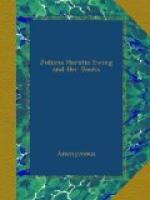TO MRS. GATTY,
Fredericton. Septuagesima, 1869.
... I am sending you two fairy stories for your editorial consideration. They are not intended to form part of “The Brownies” book—they are an experiment on my part, and I do not mean to put my name to them.
You know how fond I have always been of fairy tales of the Grimm type. Modern fairy tales always seem to me such very poor things by comparison, and I have two or three theories about the reason of this. In old days when I used to tell stories to the others, I used to have to produce them in considerable numbers and without much preparation, and as that argues a certain amount of imagination, I have determined to try if I can write a few fairy tales of the genuine “uninstructive” type by following out my theories in reference to the old traditional ones. Please don’t let out who writes them (if you put them in, and if any one cares to inquire!), for I am very anxious to hear if they elicit any comments from your correspondents to confirm me in my views. In one sense you must not expect them to be original. My aim is to imitate the “old originals,” and I mean to stick close to orthodox traditions in reference to the proceedings of elves, dwarfs, nixes, pixies, etc., and if I want them to use such “common properties of the fairy stage”—as unscrupulous foxes, stupid giants, successful younger sons, and the traditional “fool”—with much wisdom under his folly (such as Hans in Luck)—who suggests the court fools with their odd mixture of folly and shrewdness. One of my theories is that all real fairy tales (of course I do not allude to stories of a totally different character in which fairy machinery is used, as your Fairy Godmothers, my “Brownies,” etc., etc.), that all real “fairy tales” should be written as if they were oral traditions taken down from the lips of a “story teller.” This is where modern ones (and modern editions of Grimm, vide “Grimm’s Goblins,” otherwise a delicious book) fail, and the extent to which I have had to cut out reflections, abandon epithets, and shorten sentences, since I began, very much confirms my ideas. I think the Spanish ones in Aunt Judy’s Magazine must have been so obtained, and the contrast between them and the “Lost Legends” in this respect is marked. There are plenty of children who can appreciate “The Rose and the Ring,” “The Water Babies,” your books, and the most poetical and suggestive dreams of Andersen. But (if it can be done) I think there is also a strong demand for new combinations of the Step-mother, the Fox, the Luck Child, and the Kings, Princesses, Giants, Witches, etc. of the old traditions. I say combinations advisedly, for I suppose not half of Grimm’s Household Stories have “original” plots. They are palpable “rechauffees” of each other, and the few original germs might, I




